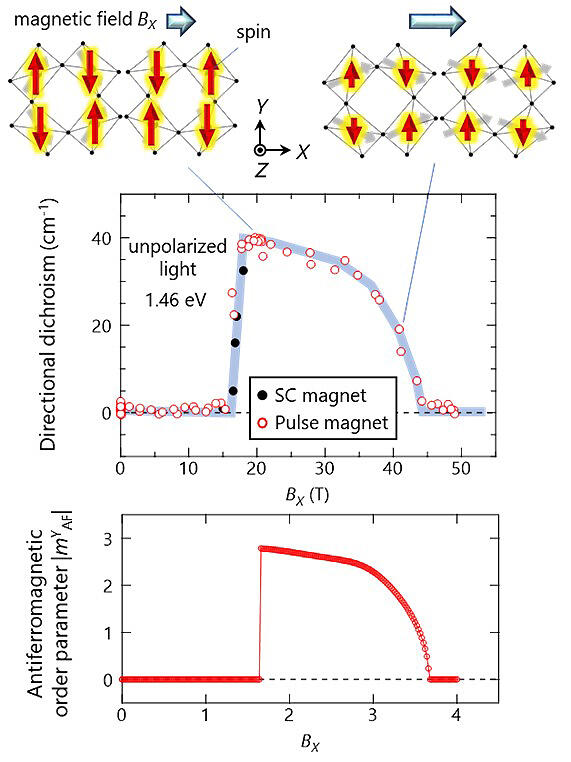The research group, comprising Assistant Professor Kenta Kimura, Professor Tsuyoshi Kimura, and others from the Graduate School of Frontier Sciences, the University of Tokyo, performed magneto-optical measurements of Pb(TiO)Cu4(PO4)4, which is an antiferromagnetic material where both space and time-reversal symmetry were broken, in a strong magnetic field of several tens of tesla. Results showed that a remarkable nonreciprocal directional dichroism with a relative change of the absorption coefficient of near-infrared light exceeding 13% appeared in the magnetic-field-induced phase under a strong magnetic field of approximately 16 T or more. This value is one to two orders of magnitude larger than the directional dichroism in antiferromagnetic materials that have been reported so far.
The research group also examined the magnetic field dependence of nonreciprocal directional dichroism from a microscopic perspective, and clarified that the signal of directional dichroism is proportional to the antiferromagnetic order parameter. When light passes through a crystal that is not symmetrical with respect to spatial inversion and time inversion, the amount of light absorbed changes when the traveling direction of light is reversed. This non-reciprocal optical phenomenon is called directional dichroism; in recent years, studies have focused on multiferroic materials (material systems having multiple properties such as ferromagnetism, ferroelectricity, and ferroelasticity) in which spatial inversion and time inversion are broken.

Provided by the University of Tokyo
Based on prior research, the research group determined that the targeted antiferromagnetic material exhibits ferroelectricity under a strong magnetic field. Because a non-reciprocal optical phenomenon called directional dichroism is expected in such a substance, directional dichroism was measured under a strong magnetic field. At that time, the research group addressed measurement difficulties such as with the design and assembly of an optical system that enables spectroscopic measurement under a pulsed strong magnetic field approaching 50 T, and the suppression of vibrations of the optical system due to the generation of a strong magnetic field. As a result, a large directional dichroism was observed in the antiferromagnetic material. This research result indicates that directional dichroism measurement under a pulsed magnetic field can be a useful method for the detection of antiferromagnetic order parameters in the strong magnetic field region, and further research is expected.
According to Assistant Professor Kenta Kimura, "In the future, we will search for antiferromagnets that express a larger directional dichroism. At the same time, we would like to take advantage of directional dichroism, which can be applied to microscopic observations and short-time measurements, and we will investigate the spatial and temporal responses of the antiferromagnetic order parameters to external stimuli such as electric field and light in addition to the pulsed magnetic field used in the present research."
This article has been translated by JST with permission from The Science News Ltd.(https://sci-news.co.jp/). Unauthorized reproduction of the article and photographs is prohibited.




